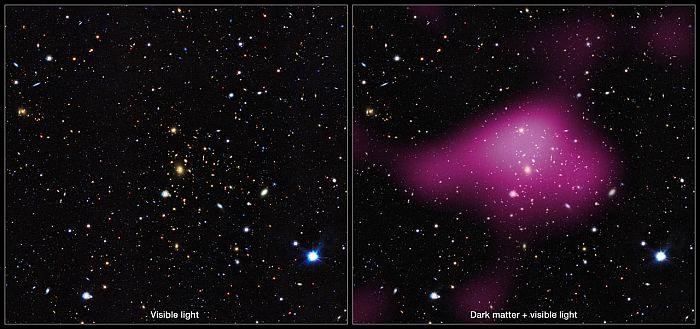Astronomers shine new light on invisible dark matter

An international team of astronomers, using data processed within the Target expertise center at the University of Groningen, announced today a series of new findings from a major dark matter survey. These are the first results from the Kilo-Degree Survey which uses ESO's VST telescope in Chile and they include as yet the most accurate measurements of dark matter distribution in groups of galaxies. Finding precisely where dark matter dwells is an important piece of the puzzle we need in order to understand not only how galaxies and galaxy clusters form in the cosmic web, but also what is the nature of the mysterious dark energy which accelerates the expansion of our Universe.
Dark matter was hypothesized as early as the 1930s but nearly a century after astronomers still can't grasp its nature and understand its properties. Devising techniques to probe dark matter is extremely challenging because it doesn't interact with electromagnetic radiation and therefore remains invisible to our telescopes. Its presence can only be inferred indirectly by measuring its gravitational pull on light, an effect known as gravitational lensing. ‘The technique we use to map the dark matter, weak gravitational lensing, is a very subtle effect. You can only measure it well from wide-area, but very sharp images of the sky. This is exactly what the VLT Survey Telescope (VST) was made for’ , says Koen Kuijken from the Leiden Observatory in the Netherlands who leads the KiDS international science team.
Focusing on mapping dark matter distribution in galaxy groups (our own Milky Way is part of a group called the Local Group), astronomers analyzed images from over two million galaxies located roughly 5 billion light years away. Kuijken and his colleagues demonstrated the most accurate measurements up to date which confirm the theoretical predictions that galaxies tend to cluster in groups. The results also show that there is 30 times more dark matter than visible matter in these groups of galaxies. 'The brightest galaxy nearly always sits in the middle of the dark matter clump," says Massimo Viola (Leiden Observatory, the Netherlands) lead author of one of the first KiDS papers. 'This prediction of galaxy formation theory, in which galaxies continue to be sucked into groups and pile up in the centre, has never been demonstrated so clearly before by observations' , adds Koen Kuijken.
Astronomers used only 7% of the total area that KiDS survey will cover. As the surveyed area grows, it will also allow fundamental measurements of the distribution of dark matter in the Universe at large, and studying of the role of the even more mysterious dark energy. The final survey will consist of massive datasets that will be made available to the global astronomical community via ESO's public archive. Target leads the production of the KiDS survey from the OmegaCAM raw data and delivery of the processed data to ESO for global public access. 'The Groningen-led massive high-quality data production was possible because at the Target expertise center we have unique expertise and powerful data infrastructure in one spot.', says Gijs Verdoes Kleijn from Target's OmegaCEN group, who is also part of the international KiDS team. Next to the dark matter results, Gijs and other members of the KiDS team used KiDS data in combination with data from the complementary VIKING survey to look for quasars, very rare objects containing supermassive black holes that are extremely bright. ‘Using VIKING we detected the second most distant quasar known, and combined with KiDS we found a number of very faint quasars. Particularly these fainter objects tell us how the first supermassive black holes were formed, and how they are related to their “host” galaxy. We are finally able to look beneath the tip of the iceberg, and study the more typical population of black holes in the first billion years after the Big Bang.' adds Gijs.
MORE INFORMATION
Target is a consortium of ten public and private partners that have set up an expertise center for R&D of large-scale scalable information systems that can handle massive (Petabyte range) data volumes. Located at the Center for Information Technology in the University of Groningen, the Netherlands, the data infrastructure facilities of Target offer extensive computational and storage power. Currently, several large scientific projects with very diverse processing and archiving requirements are hosted on the Target infrastructure (LOFAR, LifeLines, Monk, KiDS/VIKING, Euclid). Additionally, the Target consortium is strongly connected to and actively collaborates with commercial partners in order to translate its collective expertise and newly obtained insights to socially-relevant, high impact and application-driven solutions in today’s increasingly data-rich world. Stretching the possibilities of information systems to intelligently capture useful information from the continuously growing and often formidable “data avalanche” , Target aims at developing the technology that can arm society with the tools to better understand and sustainably manage the world around us.
Link to the KiDS papers
NOVA press release (in Dutch)
ESO press release
CONTACTS
Koen Kuijken, Leiden Observatory, Leiden University
Email: kuijken strw.leidenuniv.nl
Tel: +3171 527 5848
Mobile: +31 628 956 539
Personal website: http://home.strw.leidenuniv.nl/~kuijken/
Massimo Viola, Leiden Observatory, Leiden University
Email: viola strw.leidenuniv.nl
Tel: +3171 527 8442
Mobile: +31 623 410 672
Personal website: http://home.strw.leidenuniv.nl/~viola/
Gijs Verdoes Kleijn, Kapteyn Institute, University of Groningen
E-mail: verdoes astro.rug.nl
Tel: +31 50 3638326
Mobile: +31 654 658 050
Personal website: www.astro.rug.nl/~verdoes
Iva Kostadinova, Target Communications Officer
E-mail: i.kostadinova rug.nl
Tel: +31 50 363 4036
Mobile: +31 639545360
Personal website: www.astro.rug.nl/~ivona
More news
-
15 September 2025
Successful visit to the UG by Rector of Institut Teknologi Bandung
